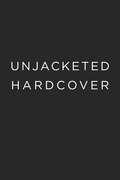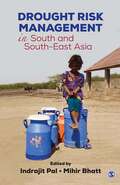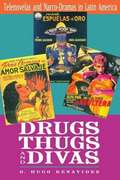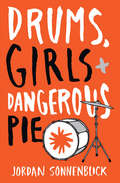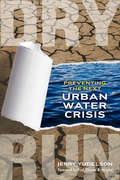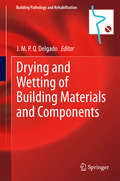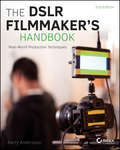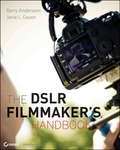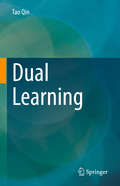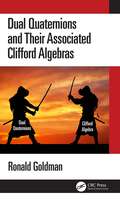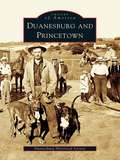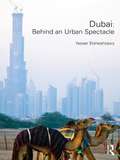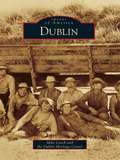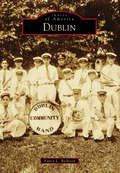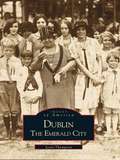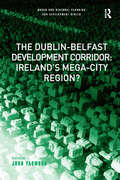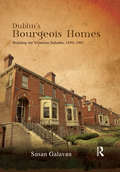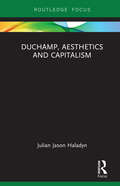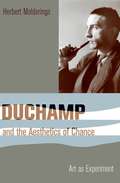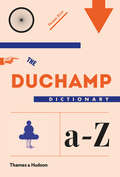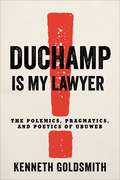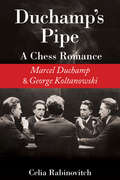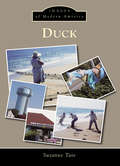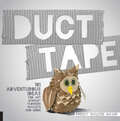- Table View
- List View
Drop That Knowledge: Youth Radio Stories
by Elisabeth Soep Vivian ChávezThis is the first book to take us inside Youth Radio for a fascinating, behind-the-scenes look at a unique, Peabody Award-winning organization that produces distinctive content for outlets from National Public Radio to YouTube.
Drought Risk Management in South and South-East Asia
by Indrajit Pal and Mihir BhattThe geo-climatic conditions of South and South-East Asian countries are diverse and vulnerable to multiple natural hazards such as drought. Drought evolves over months or even years, affects a large spatial extent and causes enormous damages. Drought Risk Management in South and South-East Asia is a comprehensive reference on overall perspectives and scenarios on drought risk mitigation and management, based on researches and case studies from South and South-East Asian countries. Drought management is a complex area of work that requires active and continuous participation of the national, provincial and local governments, multiple ministries, and divisions. This book demonstrates the best practices of socio-economic and technological interventions to enhance drought risk management, which will help to develop plans and policies, and their implementation to reduce the impact of droughts. It also offers views of field practitioners on impacts of the interventions practised at the national, sub-national and local levels.
Drugs, Thugs, and Divas
by O. Hugo BenavidesSoap opera speaks a universal language, presenting characters and plots that resonate far beyond the culture that creates them. Latin American soap operas - telenovelas - have found enthusiastic audiences throughout the Americas and Europe, as well as in Egypt, Russia, and China, while Mexican narco-dramas have become highly popular among Latinos in the United States. In this first comprehensive analysis of telenovelas and narco-dramas, Hugo Benavides assesses the dynamic role of melodrama in creating meaningful cultural images to explain why these genres have become so successful while more elite cultural productions are declining in popularity. Benavides offers close readings of the Colombian telenovelas Betty la fea (along with its Mexican and U. S. reincarnations La fea más bella and Ugly Betty), Adrián está de visita, and Pasión de gavilanes; the Brazilian historical telenovela Xica; and a variety of Mexican narco-drama films. Situating these melodramas within concrete historical developments in Latin America, he shows how telenovelas and narco-dramas serve to unite peoples of various countries and provide a voice of rebellion against often-oppressive governmental systems. Indeed, Benavides concludes that as one of the most effective and lucrative industries in Latin America, telenovelas and narco-dramas play a key role in the ongoing reconfiguration of social identities and popular culture.
Drums, Girls, and Dangerous Pie
by Jordan SonnenblickA brave and beautiful story that will make readers laugh, and break their hearts at the same time. Now with a special note from the author!Steven has a totally normal life (well, almost).He plays drums in the All-City Jazz Band (whose members call him the Peasant), has a crush on the hottest girl in school (who doesn't even know he's alive), and is constantly annoyed by his younger brother, Jeffrey (who is cuter than cute - which is also pretty annoying). But when Jeffrey gets sick, Steven's world is turned upside down, and he is forced to deal with his brother's illness, his parents' attempts to keep the family in one piece, his homework, the band, girls, and Dangerous Pie (yes, you'll have to read the book to find out what that is!).
Dry Run
by Jerry YudelsonIn the Age of Scarcity now upon us, fresh water shortages are an increasingly serious global problem. With water restrictions emerging in many developed countries and water diversions for industrial, urban, and environmental reasons stirring up oceans of controversy, there is a growing thirst for innovative approaches to reducing our water footprint. Dry Run shows the best ways to manage scarce water resources and handle upcoming urban water crises. Featuring original interviews with more than twenty-five water researchers and industry experts, this book explains water issues and proposes solutions for homes, buildings, facilities, and schools. Examining the vital linkages between water, energy use, urban development, and climate change, Dry Run demonstrates best practices for achieving "net zero" water use in the built environment, including: Water conservation strategies for buildings, factories, cities, and homes Rainwater harvesting Graywater reuse and water reclamation systems Water efficiency retrofits On-site sewage treatment New water reuse and supply technologies Ideal for concerned citizens, building managers, homeowners, architects, engineers, developers, and public officials faced with charting a course in a more arid future, Dry Run overflows with practical solutions. Jerry Yudelson, PE, LEED AP, leads the Yudelson Associates consultancy and is a leading authority on green building, clean water, and sustainable development. He is the author of eleven books, including Choosing Green and Green Building A to Z.
Drying and Wetting of Building Materials and Components
by J. M. P. Q. DelgadoThis book, Drying and Wetting of Building Materials and Components, provides a collection of recent contributions in the field of drying and wetting in porous building materials. The main benefit of the book is that it discusses some of the most important topics related to the drying and wetting processes, namely, innovations and trends in drying science and technology, drying mechanism and theory, equipment, advanced modelling, complex simulation and experimentation. At the same time, these topics will be going to the encounter of a variety of scientific and engineering disciplines. The book is divided in several chapters that intend to be a resume of the current state of knowledge for benefit of professional colleagues.
The DSLR Filmmaker's Handbook
by Barry AnderssonLearn to shoot professional-quality HD footage with your DSLR Camera The DSLR Filmmaker's Handbook, 2nd Edition is the expert guide to getting professional movie-making results with an HD video-enabled DSLR camera. Fully updated to reflect the latest technology, this updated edition provides guidance toward best practices and techniques that maximize results. Shooting HD video with a DSLR has many benefits -- and also a few tricky drawbacks -- but this guide gives you the insight and training you need to overcome these challenges as you learn what to anticipate, how to work around it, and how to fix imperfections in post-production. Award winning independent filmmaker Barry Andersson walks you through the shooting process and shows you what to do before, during, and after filming to ensure high quality results. Most of today's DSLRs have the capacity to shoot HD video. This, combined with incredible low-light capabilities, shallow depth of field, and relatively low price point make these cameras an extremely attractive entry point for would-be independent filmmakers. This book shows you how to exploit your DSLR's capabilities to produce beautiful film, with step-by-step expert instruction. Understand the limitations of DSLR video Learn what to plan for before filming begins Exploit HD capabilities to maximize the film's visuals Produce professional-level, film-quality footage With thorough explanations and expert instruction, The DSLR Filmmaker's Handbook, 2nd Edition is the training you need to start shooting beautiful HD footage.
The DSLR Filmmaker's Handbook
by Barry Andersson Janie L. GeyenA how-to guide for getting professional-quality video from your DSLR Shooting HD Video with a video-enabled DSLR has many benefits and some tricky drawbacks that digital filmmakers and videographers can overcome to get professional results. The DSLR Filmmaker's Handbook helps filmmakers harness the HD video capabilities of their DSLRs to create professional-level video. Packed with professionally-tested techniques, this indispensible book serves as a training guide for the complex steps that must be taken before, during, and after filming. Teaches you the key tools and techniques for using your DSLR to shoot high-quality, professional-level video Distills dense information about filmmaking and filters it down to easily understood granules Shows you what to expect and what to avoid with your DSLR and how to maximize the visual look of your film Shares tools and techniques that have been used in real-world, independent movie-making environments The DSLR Filmmaker's Handbook shows you how to overcome any tricky drawbacks that you may face while shooting HD video with your DSLR.
Dual Learning
by Tao QinMany AI (and machine learning) tasks present in dual forms, e.g., English-to-Chinese translation vs. Chinese-to-English translation, speech recognition vs. speech synthesis,question answering vs. question generation, and image classification vs. image generation. Dual learning is a new learning framework that leverages the primal-dual structure of AI tasks to obtain effective feedback or regularization signals in order to enhance the learning/inference process. Since it was first introduced four years ago, the concept has attracted considerable attention in multiple fields, and been proven effective in numerous applications, such as machine translation, image-to-image translation, speech synthesis and recognition, (visual) question answering and generation, image captioning and generation, and code summarization and generation. Offering a systematic and comprehensive overview of dual learning, this book enables interested researchers (both established and newcomers) and practitioners to gain a better understanding of the state of the art in the field. It also provides suggestions for further reading and tools to help readers advance the area. The book is divided into five parts. The first part gives a brief introduction to machine learning and deep learning. The second part introduces the algorithms based on the dual reconstruction principle using machine translation, image translation, speech processing and other NLP/CV tasks as the demo applications. It covers algorithms, such as dual semi-supervised learning, dual unsupervised learning and multi-agent dual learning. In the context of image translation, it introduces algorithms including CycleGAN, DualGAN, DiscoGAN cdGAN and more recent techniques/applications. The third part presents various work based on the probability principle, including dual supervised learning and dual inference based on the joint-probability principle and dual semi-supervised learning based on the marginal-probability principle. The fourth part reviews various theoretical studies on dual learning and discusses its connections to other learning paradigms. The fifth part provides a summary and suggests future research directions.
Dual Quaternions and Their Associated Clifford Algebras
by Ronald GoldmanClifford algebra for dual quaternions has emerged recently as an alternative to standard matrix algebra as a computational framework for computer graphics. This book presents dual quaternions and their associated Clifford algebras in a new light, accessible to and geared toward the computer graphics community. Collecting all the associated formulas and theorems in one place, this book provides an extensive and rigorous treatment of dual quaternions, as well as showing how two models of Clifford algebra emerge naturally from the theory of dual quaternions. Each section comes complete with a set of exercises to help readers sharpen and practice their understanding. This book is accessible to anyone with a basic knowledge of quaternion algebra and is of particular use to forward-thinking members of the computer graphics community.
Duanesburg and Princetown
by Duanesburg Historical SocietyDuanesburg and Princetown depicts the two westernmost hill towns of Schenectady County. Settlers arrived in the region in the mid-1700s, and eventually hamlets grew up where they clustered: Quaker Street, Delanson, Mariaville,Eaton's Corners, Braman's Corners, Duanesburg Four Corners, Rynex Corners, Gifford's, Princetown Hamlet, and Kelly's Station. Images from these hamlets provide glimpses of more than two centuries of American endeavor, including early styles of architecture and the largest coaling station in the world in 1907, natural sites of extraordinary beauty and interest, and a progression of religious, social, political,and economic activity.
Dubai: Behind an Urban Spectacle (Planning, History and Environment Series)
by Yasser ElsheshtawyYasser Elsheshtawy explores Dubai’s history from its beginnings as a small fishing village to its place on the world stage today, using historical narratives, travel descriptions, novels and fictional accounts by local writers to bring colour to his history of the city’s urban development. With the help of case studies and surveys this book explores the economic and political forces driving Dubai’s urban growth, its changing urbanity and its place within the global city network. Uniquely, it looks beyond the glamour of Dubai’s mega-projects, and provides an in-depth exploration of a select set of spaces which reveal the city’s ‘inner life’.
Dublin (Images of America)
by Mike Lynch Dublin Heritage CenterNestled in the wooded hills east of the San Francisco Bay, Dublin's sprawling valley has welcomed people from a variety of backgroundsthroughout its rich history. At the heart of the tri-valley region, this former agricultural area has grown exponentially over the years, forming a moderncity with a solid community-oriented heritage. From California's first native inhabitants, through the Spanish and Mexican periods, to the arrival of the first American settlers, Dublin has long been at the crossroads of culture and settlement.
Dublin (Images of America)
by Nancy L. RichisonThroughout history, the city of Dublin's rich, verdant land has attracted settlers and visitors alike. Native Americans first inhabited the area in the days before the US government gave Continental Army soldiers property along the banks of the Scioto River as payment for service in the Revolutionary War. Platted as a village in 1810, Dublin's early settlers included John Sells, who offered surveyor John Shields the privilege of naming the new settlement. Legend has it that the lush vegetation prompted Shields to bestow the name of his homeland: Dublin, Ireland. Dublin, Ohio, would remain a sleepy little burg until the 1960s and 1970s, when three major changes led to explosive growth: the construction of Interstate 270, the development of Jack Nicklaus's Muirfield Village Golf Club and residential neighborhood, and the arrival of Ashland, Inc. Today, Dublin is known as a golf mecca--home of the PGA Tour's Memorial Tournament--and an international corporate headquarters, with The Wendy's Company, Stanley Steemer, and Cardinal Health among its marquee businesses.
Dublin: The Emerald City (Images of America)
by Scott ThompsonAt the dawn of the twentieth century, Dublin, Georgia, was transformed from a violent and lawless community into one of the state's fastest growing, most prosperous and cultivated cities. The coming of the railroad, the prohibition of liquor sales, and evolving industries all played a part in escortingDublin into this "Golden Era," a period of unparalleled expansion and exuberance. With over two hundred historic photographs, Dublin: The Emerald City takes the reader on a journey into Dublin's storied past, tracing the major events that gave Dublin its sense of community and restored pride in its residents following years of turmoil. Included are images of the town's early homes, businesses, churches, and schools, as well as local festivals, fairs, and sports teams. Although the town's Golden Era came to an untimely end with the invasion of the boll weevil, the influenza epidemic of 1918, and the devastation of lives lost during the First World War, Dublin is still a spirited community, growing and changing with the times while reflecting upon a colorful history.
The Dublin-Belfast Development Corridor: Ireland’s Mega-City Region? (Urban and Regional Planning and Development Series)
by John YarwoodThe aim of the Dublin-Belfast Development Corridor is to link several towns and cities by various modes of communication in order to create a poly-centric mega-city region in Ireland on a scale large enough to compete with the major urban clusters of continental Europe. This volume brings together an interdisciplinary team of leading scholars and practitioners from both sides of the border to discuss the Dublin-Belfast corridor and the associated challenges of cross-border development from economic, geographic, regional studies, sociological and planning perspectives. As well as providing insight into this important project, the book also throws light on regional development more generally.
Dublin’s Bourgeois Homes: Building the Victorian Suburbs, 1850-1901
by Susan GalavanIn 1859, Dubliners strolling along country roads witnessed something new emerging from the green fields. The Victorian house had arrived: wide red brick structures stood back behind manicured front lawns. Over the next forty years, an estimated 35,000 of these homes were constructed in the fields surrounding the city. The most elaborate were built for Dublin’s upper middle classes, distinguished by their granite staircases and decorative entrances. Today, they are some of the Irish capital’s most highly valued structures, and are protected under strict conservation laws. Dublin’s Bourgeois Homes is the first in-depth analysis of the city’s upper middle-class houses. Focusing on the work of three entrepreneurial developers, Susan Galavan follows in their footsteps as they speculated in house building: signing leases, acquiring plots and sourcing bricks and mortar. She analyses a select range of homes in three different districts: Ballsbridge, Rathgar and Kingstown (now Dun Laoghaire), exploring their architectural characteristics: from external form to plan type, and detailing of materials. Using measured surveys, photographs, and contemporary drawings and maps, she shows how house design evolved over time, as bay windows pushed through façades and new lines of coloured brick were introduced. Taking the reader behind the façades into the interiors, she shows how domestic space reflected the lifestyle and aspirations of the Victorian middle classes. This analysis of the planning, design and execution of Dublin’s bourgeois homes is an original contribution to the history of an important city in the British Empire.
Duchamp, Aesthetics and Capitalism (Routledge Focus on Art History and Visual Studies)
by Julian Jason HaladynThis book is a significant re-thinking of Duchamp’s importance in the twenty-first century, taking seriously the readymade as a critical exploration of object-oriented relations under the conditions of consumer capitalism. The readymade is understood as an act of accelerating art as a discourse, of pushing to the point of excess the philosophical precepts of modern aesthetics on which the notion of art in modernity is based. Julian Haladyn argues for an accelerated Duchamp that speaks to a contemporary condition of art within our era of globalized capitalist production.
Duchamp and the Aesthetics of Chance: Art as Experiment
by John Brogden Herbert MolderingsMarcel Duchamp is often viewed as an "artist-engineer-scientist," a kind of rationalist who relied heavily on the ideas of the French mathematician and philosopher Henri Poincaré. Yet a complete portrait of Duchamp and his multiple influences draws a different picture. In his 3 Standard Stoppages (1913-1914), a work that uses chance as an artistic medium, we see how far Duchamp subverted scientism in favor of a radical individualistic aesthetic and experimental vision. Unlike the Dadaists, Duchamp did more than dismiss or negate the authority of science. He pushed scientific rationalism to the point where its claims broke down and alternative truths were allowed to emerge. With humor and irony, Duchamp undertook a method of artistic research, reflection, and visual thought that focused less on beauty than on the notion of the "possible. " He became a passionate advocate of the power of invention and thinking things that had never been thought before. The 3 Standard Stoppages is the ultimate realization of the play between chance and dimension, visibility and invisibility, high and low art, and art and anti-art. Situating Duchamp firmly within the literature and philosophy of his time, Herbert Molderings recaptures the spirit of a frequently misread artist--and his thrilling aesthetic of chance.
Duchamp and the Aesthetics of Chance: Art as Experiment (Columbia Themes in Philosophy, Social Criticism, and the Arts)
by Herbert MolderingsMarcel Duchamp is often viewed as an "artist-engineer-scientist," a kind of rationalist who relied heavily on the ideas of the French mathematician and philosopher Henri Poincaré. Yet a complete portrait of Duchamp and his multiple influences draws a different picture. In his 3 Standard Stoppages (1913-1914), a work that uses chance as an artistic medium, we see how far Duchamp subverted scientism in favor of a radical individualistic aesthetic and experimental vision.Unlike the Dadaists, Duchamp did more than dismiss or negate the authority of science. He pushed scientific rationalism to the point where its claims broke down and alternative truths were allowed to emerge. With humor and irony, Duchamp undertook a method of artistic research, reflection, and visual thought that focused less on beauty than on the notion of the "possible." He became a passionate advocate of the power of invention and thinking things that had never been thought before. The 3 Standard Stoppages is the ultimate realization of the play between chance and dimension, visibility and invisibility, high and low art, and art and anti-art. Situating Duchamp firmly within the literature and philosophy of his time, Herbert Molderings recaptures the spirit of a frequently misread artist-and his thrilling aesthetic of chance.
The Duchamp Dictionary
by Luke Frost Therese Vandling Thomas Girst"Girst elegantly unravels the skeins of Duchamp's thinking. . . . An essential compendium for puzzling out an essential artist." --Richard Armstrong, Director of the Solomon R. Guggenheim Museum and Foundation Among the most influential artists of the last hundred years, Marcel Duchamp holds great allure for many contemporary artists worldwide and is largely considered to be one of the founding fathers of modern art. Despite this popularity, books on Duchamp are often hyper-theoretical, rarely presenting the artist in an accessible way. This new book explores the artist's life and work through short, alphabetical dictionary entries that introduce his legacy in a clear and engaging way. From alchemy and anatomy to Warhol and windows, The Duchamp Dictionary offers a pithy and readable text that draws on in-depth scholarship and the very latest research. Thomas Girst includes close to 200 entries on the most interesting and important artworks, relationships, people, and ideas in Duchamp's life--from The Bicycle Wheel and Fountain to Walter and Louise Arensberg, Peggy Guggenheim, Katherine Dreier, and Arturo Schwarz. Delightful, newly commissioned illustrations introduce each letter of the alphabet and accompany select entries, capturing the irreverent spirit of the artist himself.
Duchamp Is My Lawyer: The Polemics, Pragmatics, and Poetics of UbuWeb
by Kenneth GoldsmithIn 1996, during the relatively early days of the web, Kenneth Goldsmith created UbuWeb to post hard-to-find works of concrete poetry. What started out as a site to share works from a relatively obscure literary movement grew into an essential archive of twentieth- and twenty-first-century avant-garde and experimental literature, film, and music. Visitors around the world now have access to both obscure and canonical works, from artists such as Kara Walker, Yoko Ono, Pauline Oliveros, Samuel Beckett, Marcel Duchamp, Cecil Taylor, Glenn Ligon, William Burroughs, and Jean-Luc Godard.In Duchamp Is My Lawyer, Goldsmith tells the history of UbuWeb, explaining the motivations behind its creation and how artistic works are archived, consumed, and distributed online. Based on his own experiences and interviews with a variety of experts, Goldsmith describes how the site navigates issues of copyright and the ways that UbuWeb challenges familiar configurations and histories of the avant-garde. The book also portrays the growth of other “shadow libraries” and includes a section on the artists whose works reflect the aims, aesthetics, and ethos of UbuWeb. Goldsmith concludes by contrasting UbuWeb’s commitment to the free-culture movement and giving access to a wide range of artistic works with today’s gatekeepers of algorithmic culture, such as Netflix, Amazon, and Spotify.
Duchamp's Pipe: A Chess Romance--Marcel Duchamp and George Koltanowski
by Celia RabinovitchArt, chess, and an $87,000 pipe frame an inside look at the relationship between Dadaist artist Marcel Duchamp and chess Grandmaster George KoltanowskiSpanning three decades, two continents, two world wars, and the international art and chess scenes of the mid twentieth century, Duchamp's Pipe explores the remarkable friendship between art world enfant terrible Marcel Duchamp and blindfold chess champion George Koltanowski. Artist and cultural historian Celia Rabinovitch describes each man's rise to prominence, the chess matches that sparked their relationship, and the recently discovered pipe that Duchamp gave to Koltanowski. This tale of genius and resilience offers fresh insights into the essence of the gift in the bohemian underground. Rabinovitch invites us to discover the chess wizard and a Duchamp slightly off pedestal--and ultimately more human.
Duck
by Suzanne TateSituated on the Atlantic Flyway, Duck was given its name by the first postmaster, Lloyd Toler, who operated a tiny store in the community. While Duck is the Outer Banks' newest town, officially established in 2002, it has a long and interesting history, one that has always focused on fishing. Duck was once a quiet little village, with both able-bodied men and women actively engaged in maritime activities. Located on a narrow strip of land between Currituck Sound and the Atlantic Ocean, the town has a thriving commercial district, and visitors enjoy the boardwalk along the sound, six miles of pristine beaches, and a town park. Duck showcases the evolution of this community, from a small fishing village to a popular resort destination on the North Carolina coast.
Duct Tape: 101 Adventurous Ideas for Art, Jewelry, Flowers, Wallets, and More
by Forest Walker DavisDiscover the creative possibilities with this inspiring collection of 101 duct-tape craft projects!Move beyond the wallet with these exciting duct tape projects that make amazing use of the simple but versatile material. Each project is fully illustrated and contains easy-to-follow instructions for creating inexpensive craft projects of the utmost quality and aesthetic.Sturdy and resistant, and with a myriad of interesting colors and patterns, duct tape is a perfect crafting, home, and DIY material, and the Tape Guy, Forest Walker Davis, helps you to create more than mere embellishments. Try making frames, bags, flowers, clothes, bow ties, and more. These projects are just the beginning. Durable and safe to use almost anywhere, duct-tape projects are great fun for crafters of any age!
